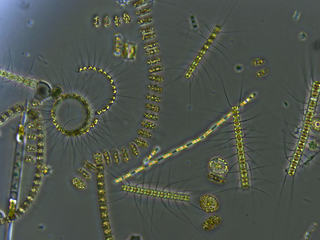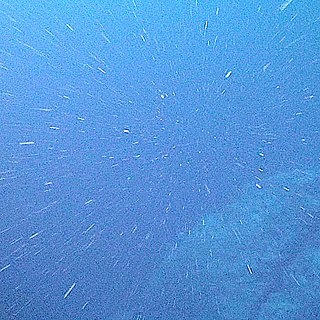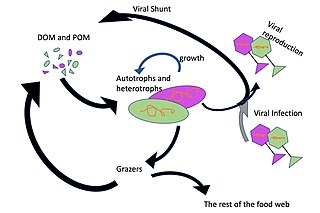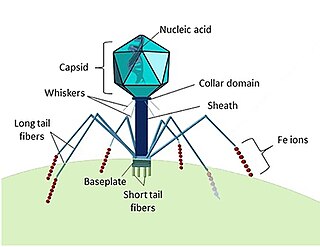The microbial food web refers to the combined trophic interactions among microbes in aquatic environments. These microbes include viruses, bacteria, algae, heterotrophic protists (such as ciliates and flagellates). [1] In aquatic ecosystems, microbial food webs are essential because they form the basis for the cycling of nutrients and energy. These webs are vital to the stability and production of ecosystems in a variety of aquatic environments, including lakes, rivers, and oceans. By converting dissolved organic carbon (DOC) and other nutrients into biomass that larger organisms may eat, microbial food webs maintain higher trophic levels. Thus, these webs are crucial for energy flow and nutrient cycling in both freshwater and marine ecosystems. [2]
In aquatic environments, microbes constitute the base of the food web. Single celled photosynthetic organisms such as diatoms and cyanobacteria are generally the most important primary producers in the open ocean. Many of these cells, especially cyanobacteria, are too small to be captured and consumed by small crustaceans and planktonic larvae. Instead, these cells are consumed by phagotrophic protists which are readily consumed by larger organisms. [3]
Viruses
Aquatic ecosystems are full of viruses, which are essential for managing microbial populations. They release organic matter back into the environment by infecting and lysing planktonic algae (phycoviruses) and bacterial cells (bacteriophages). This mechanism, called the viral shunt, promotes nutrient recycling and aids in the control of microbial populations. Viral particles and dissolved organic carbon (DOC), which can be further used by other microorganisms, are released when bacterial cells are lysed. Viruses can infect and break open bacterial cells and (to a lesser extent), planktonic algae (a.k.a. phytoplankton). Therefore, viruses in the microbial food web act to reduce the population of bacteria and, by lysing bacterial cells, release particulate and dissolved organic carbon (DOC). [4]
Bacteria
In the microbial food web, bacteria play a crucial role in breaking down organic materials and recycling nutrients. They transform DOC into bacterial biomass so that protists and other higher trophic levels can consume it. Additionally, bacteria take part in the nitrogen and carbon cycles, among other biogeochemical cycles. [4]
Algae
In aquatic ecosystems, single-celled photosynthetic organisms like cyanobacteria and diatoms are the main producers. Through the process of photosynthesis, they transform sunlight into chemical energy and create organic matter, which is the foundation of the food chain. Particularly significant in nutrient-poor environments are cyanobacteria because of their capacity to fix atmospheric nitrogen. When vital nutrients like nitrogen and phosphorus are scarce during periods of uneven development, algal cells have the potential to produce DOC. DOC may also be released into the environment by algal cells. One of the reasons phytoplankton release DOC termed "unbalanced growth" is when essential nutrients (e.g. nitrogen and phosphorus) are limiting. Therefore, carbon produced during photosynthesis is not used for the synthesis of proteins (and subsequent cell growth), but is limited due to a lack of the nutrients necessary for macromolecules. Excess photosynthate, or DOC is then released, or exuded. [3]
Heterotrophic Protists
In the microbial food web, protists including ciliates and flagellates are significant consumers. By consuming bacteria, algae, and other tiny particles, they move nutrients and energy up the food chain. Larger creatures like zooplankton feed on these protists in turn. [3]
The food web's microbial interactions are varied and diverse. Predation, rivalry, and symbiotic connections are some of these interactions. For instance, certain bacteria and algae create mutualistic relationships in which the bacteria give the algae vital nutrients, and the algae give the bacteria organic carbon. Microbial communities can be shaped by competition for resources like light and nutrition, which can affect their makeup and functionality. [5]
Environmental factors that have a significant impact on microbial food webs include temperature, availability of light, and nutrient concentrations. Microbe development and metabolic rates are influenced by temperature, and photosynthetic organisms are impacted by light availability. The availability of nutrients, especially phosphorus and nitrogen, might restrict the growth and productivity of microorganisms. For instance, during times of nitrogen constraint, phytoplankton may emit DOC, a phenomenon referred to as imbalanced growth. [6]
A major impact of human activity on microbial food webs is eutrophication, pollution, and climate change. The activities of microbial communities can be disturbed by pollutants like pesticides and heavy metals. Microbial growth and dispersal are impacted by temperature and precipitation changes brought about by climate change. The entire aquatic food chain may be impacted by eutrophication, which is brought on by nutrient runoff from cities and farms. Eutrophication can also result in toxic algal blooms and hypoxic conditions. [7]
Technological developments have completely changed the way that microbial food webs are studied. By analyzing genetic material from environmental samples, researchers can get insights into the diversity and roles of microbial communities using metagenomics. The utilization of remote sensing technology facilitates the large-scale monitoring of environmental variables and microbial activity, consequently augmenting our comprehension of microbial dynamics across various ecosystems. [8]
The microbial loop describes a pathway in the microbial food web where DOC is returned to higher trophic levels via the incorporation into bacterial biomass. This loop makes sure that the DOC created by photosynthetic organisms is used by heterotrophic bacteria and then moves up the food chain, which is crucial for sustaining the flow of nutrients and energy within the ecosystem. [7]
By facilitating the transfer of nutrients and energy, microbial food webs are essential for the health and stability of aquatic ecosystems. It is crucial to comprehend these complex relationships to address environmental issues and advance sustainable management of aquatic resources. Technological developments keep expanding our understanding and illuminating the complex mechanisms that support life in the oceans of our planet.

Plankton are the diverse collection of organisms that drift in water but are unable to actively propel themselves against currents. The individual organisms constituting plankton are called plankters. In the ocean, they provide a crucial source of food to many small and large aquatic organisms, such as bivalves, fish, and baleen whales.

Phytoplankton are the autotrophic (self-feeding) components of the plankton community and a key part of ocean and freshwater ecosystems. The name comes from the Greek words φυτόν, meaning 'plant', and πλαγκτός, meaning 'wanderer' or 'drifter'.

Zooplankton are the heterotrophic component of the planktonic community, having to consume other organisms to thrive. Plankton are aquatic organisms that are unable to swim effectively against currents. Consequently, they drift or are carried along by currents in the ocean, or by currents in seas, lakes or rivers.

The microbial loop describes a trophic pathway where, in aquatic systems, dissolved organic carbon (DOC) is returned to higher trophic levels via its incorporation into bacterial biomass, and then coupled with the classic food chain formed by phytoplankton-zooplankton-nekton. In soil systems, the microbial loop refers to soil carbon. The term microbial loop was coined by Farooq Azam, Tom Fenchel et al. in 1983 to include the role played by bacteria in the carbon and nutrient cycles of the marine environment.

Phototrophic biofilms are microbial communities generally comprising both phototrophic microorganisms, which use light as their energy source, and chemoheterotrophs. Thick laminated multilayered phototrophic biofilms are usually referred to as microbial mats or phototrophic mats. These organisms, which can be prokaryotic or eukaryotic organisms like bacteria, cyanobacteria, fungi, and microalgae, make up diverse microbial communities that are affixed in a mucous matrix, or film. These biofilms occur on contact surfaces in a range of terrestrial and aquatic environments. The formation of biofilms is a complex process and is dependent upon the availability of light as well as the relationships between the microorganisms. Biofilms serve a variety of roles in aquatic, terrestrial, and extreme environments; these roles include functions which are both beneficial and detrimental to the environment. In addition to these natural roles, phototrophic biofilms have also been adapted for applications such as crop production and protection, bioremediation, and wastewater treatment.

In the deep ocean, marine snow is a continuous shower of mostly organic detritus falling from the upper layers of the water column. It is a significant means of exporting energy from the light-rich photic zone to the aphotic zone below, which is referred to as the biological pump. Export production is the amount of organic matter produced in the ocean by primary production that is not recycled (remineralised) before it sinks into the aphotic zone. Because of the role of export production in the ocean's biological pump, it is typically measured in units of carbon. The term was coined by explorer William Beebe as observed from his bathysphere. As the origin of marine snow lies in activities within the productive photic zone, the prevalence of marine snow changes with seasonal fluctuations in photosynthetic activity and ocean currents. Marine snow can be an important food source for organisms living in the aphotic zone, particularly for organisms that live very deep in the water column.

Bacterioplankton refers to the bacterial component of the plankton that drifts in the water column. The name comes from the Ancient Greek word πλαγκτός (planktós), meaning "wandering" or "drifting", and bacterium, a Latin term coined in the 19th century by Christian Gottfried Ehrenberg. They are found in both seawater and fresh water.
A mixotroph is an organism that uses a mix of different sources of energy and carbon, instead of having a single trophic mode, on the continuum from complete autotrophy to complete heterotrophy. It is estimated that mixotrophs comprise more than half of all microscopic plankton. There are two types of eukaryotic mixotrophs. There are those with their own chloroplasts – including those with endosymbionts providing the chloroplasts. And there are those that acquire them through kleptoplasty, or through symbiotic associations with prey, or through 'enslavement' of the prey's organelles.

Marine microorganisms are defined by their habitat as microorganisms living in a marine environment, that is, in the saltwater of a sea or ocean or the brackish water of a coastal estuary. A microorganism is any microscopic living organism or virus, which is invisibly small to the unaided human eye without magnification. Microorganisms are very diverse. They can be single-celled or multicellular and include bacteria, archaea, viruses, and most protozoa, as well as some fungi, algae, and animals, such as rotifers and copepods. Many macroscopic animals and plants have microscopic juvenile stages. Some microbiologists also classify viruses as microorganisms, but others consider these as non-living.
Soil microbiology is the study of microorganisms in soil, their functions, and how they affect soil properties. It is believed that between two and four billion years ago, the first ancient bacteria and microorganisms came about on Earth's oceans. These bacteria could fix nitrogen, in time multiplied, and as a result released oxygen into the atmosphere. This led to more advanced microorganisms, which are important because they affect soil structure and fertility. Soil microorganisms can be classified as bacteria, actinomycetes, fungi, algae and protozoa. Each of these groups has characteristics that define them and their functions in soil.

The phycosphere is a microscale mucus region that is rich in organic matter surrounding a phytoplankton cell. This area is high in nutrients due to extracellular waste from the phytoplankton cell and it has been suggested that bacteria inhabit this area to feed on these nutrients. This high nutrient environment creates a microbiome and a diverse food web for microbes such as bacteria and protists. It has also been suggested that the bacterial assemblages within the phycosphere are species-specific and can vary depending on different environmental factors.

Mycoplankton are saprotrophic members of the plankton communities of marine and freshwater ecosystems. They are composed of filamentous free-living fungi and yeasts that are associated with planktonic particles or phytoplankton. Similar to bacterioplankton, these aquatic fungi play a significant role in heterotrophicmineralization and nutrient cycling. Mycoplankton can be up to 20 mm in diameter and over 50 mm in length.

Dinoflagellates are eukaryotic plankton, existing in marine and freshwater environments. Previously, dinoflagellates had been grouped into two categories, phagotrophs and phototrophs. Mixotrophs, however include a combination of phagotrophy and phototrophy. Mixotrophic dinoflagellates are a sub-type of planktonic dinoflagellates and are part of the phylum Dinoflagellata. They are flagellated eukaryotes that combine photoautotrophy when light is available, and heterotrophy via phagocytosis. Dinoflagellates are one of the most diverse and numerous species of phytoplankton, second to diatoms.

The viral shunt is a mechanism that prevents marine microbial particulate organic matter (POM) from migrating up trophic levels by recycling them into dissolved organic matter (DOM), which can be readily taken up by microorganisms. The DOM recycled by the viral shunt pathway is comparable to the amount generated by the other main sources of marine DOM.

A marine food web is a food web of marine life. At the base of the ocean food web are single-celled algae and other plant-like organisms known as phytoplankton. The second trophic level is occupied by zooplankton which feed off the phytoplankton. Higher order consumers complete the web. There has been increasing recognition in recent years that marine microorganisms.

Marine primary production is the chemical synthesis in the ocean of organic compounds from atmospheric or dissolved carbon dioxide. It principally occurs through the process of photosynthesis, which uses light as its source of energy, but it also occurs through chemosynthesis, which uses the oxidation or reduction of inorganic chemical compounds as its source of energy. Almost all life on Earth relies directly or indirectly on primary production. The organisms responsible for primary production are called primary producers or autotrophs.

Marine viruses are defined by their habitat as viruses that are found in marine environments, that is, in the saltwater of seas or oceans or the brackish water of coastal estuaries. Viruses are small infectious agents that can only replicate inside the living cells of a host organism, because they need the replication machinery of the host to do so. They can infect all types of life forms, from animals and plants to microorganisms, including bacteria and archaea.

Marine prokaryotes are marine bacteria and marine archaea. They are defined by their habitat as prokaryotes that live in marine environments, that is, in the saltwater of seas or oceans or the brackish water of coastal estuaries. All cellular life forms can be divided into prokaryotes and eukaryotes. Eukaryotes are organisms whose cells have a nucleus enclosed within membranes, whereas prokaryotes are the organisms that do not have a nucleus enclosed within a membrane. The three-domain system of classifying life adds another division: the prokaryotes are divided into two domains of life, the microscopic bacteria and the microscopic archaea, while everything else, the eukaryotes, become the third domain.

Marine protists are defined by their habitat as protists that live in marine environments, that is, in the saltwater of seas or oceans or the brackish water of coastal estuaries. Life originated as marine single-celled prokaryotes and later evolved into more complex eukaryotes. Eukaryotes are the more developed life forms known as plants, animals, fungi and protists. Protists are the eukaryotes that cannot be classified as plants, fungi or animals. They are mostly single-celled and microscopic. The term protist came into use historically as a term of convenience for eukaryotes that cannot be strictly classified as plants, animals or fungi. They are not a part of modern cladistics because they are paraphyletic.

Phytoplankton are characterized as organisms which are unable to swim against a current and produce their own organic carbon via photosynthesis. They are responsible for producing approximately 50 percent of the Earth’s primary productivity and are therefore crucial in maintaining both marine ecosystems and adding a significant amount of oxygen to the atmosphere. However, as with other organisms, phytoplankton are hosts to many diverse forms of parasites, including, but not limited to, fungal- and non-fungal zoosporic parasites, Dinoflagellates, Cercozoans, and viruses. Parasites use nutrients from their hosts, at that organisms expense, and display diverse methods of infection. Parasites can play integral roles in the dynamics and interactions between phytoplankton and their communities, such as controlling population abundance, distribution and biodiversity.
{{cite web}}: CS1 maint: multiple names: authors list (link) CS1 maint: numeric names: authors list (link){{cite web}}: CS1 maint: multiple names: authors list (link) CS1 maint: numeric names: authors list (link){{cite web}}: CS1 maint: numeric names: authors list (link){{cite web}}: CS1 maint: multiple names: authors list (link) CS1 maint: numeric names: authors list (link){{cite web}}: CS1 maint: numeric names: authors list (link){{cite web}}: CS1 maint: multiple names: authors list (link) CS1 maint: numeric names: authors list (link){{cite web}}: CS1 maint: multiple names: authors list (link) CS1 maint: numeric names: authors list (link)